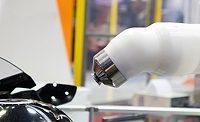When is it Worth Investing in Paint Line Automation?

 Embracing an automatic electrostatic powder coating line is not just a change, it's a strategic move that can unlock numerous benefits. Marcelo Camargo, Engineer, and Director of Cetec, a company specializing in manufacturing industrial painting equipment, explains that this shift becomes advantageous when the area to be manually painted exceeds one m² per minute. “If the product line has simple geometry and reduced colors, automation can be implemented quickly, bringing significant efficiency and savings,” he notes.
Embracing an automatic electrostatic powder coating line is not just a change, it's a strategic move that can unlock numerous benefits. Marcelo Camargo, Engineer, and Director of Cetec, a company specializing in manufacturing industrial painting equipment, explains that this shift becomes advantageous when the area to be manually painted exceeds one m² per minute. “If the product line has simple geometry and reduced colors, automation can be implemented quickly, bringing significant efficiency and savings,” he notes.
A typical manual line requires three to four people: one to hang the part, one to paint, one to take it in and out, and one to remove it from the oven and disassemble the hook. In contrast, an automatic line can operate with just two people, one to hang it and one to remove it, leading to a substantial reduction in operating costs.
“If we consider a company that spends $25,000 per month on painting, the $180,000 investment in an automatic line is recovered in approximately eight months,” says Camargo. The payback calculation takes into account savings on labor and greater process efficiency.
Automation offers other essential benefits. For example, it guarantees layer uniformity, ensuring consistent quality across all parts. In addition, it reduces input waste, optimizes paint consumption, and speeds up the painting process, increasing productivity.
At the same time, automatic paint recovery, a process that collects overspray and reuses it, minimizes losses and maximizes the use of resources, making the process more sustainable. “Automation establishes an accelerated production pace, following the Henry Ford principle,” he comments.
Cetec’s equipment, which includes robots, powder feed tanks, electrostatic control systems, and spray guns, among others, is not just about immediate gains. It's designed to make the production line more efficient and economical in the long term, ensuring a secure and confident investment. In South America, more than 450 automated painting lines operate with equipment supplied by the company.
“These are ideal solutions for various sectors, such as transportation, construction, agriculture, white goods, furniture, fitness, and leisure,” concludes Camargo.
*Images courtesy of Cetec.
Looking for a reprint of this article?
From high-res PDFs to custom plaques, order your copy today!







